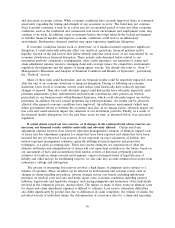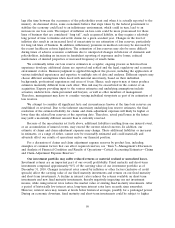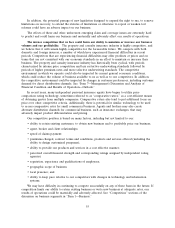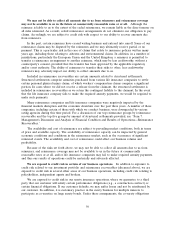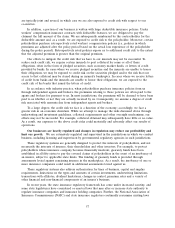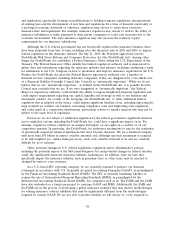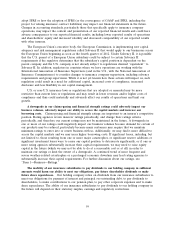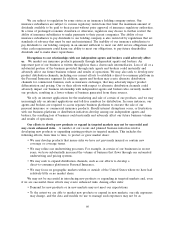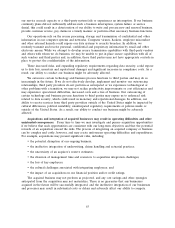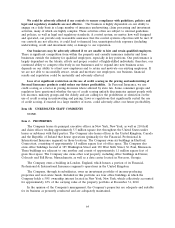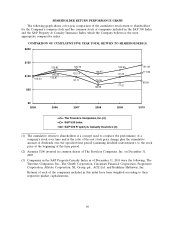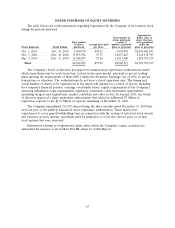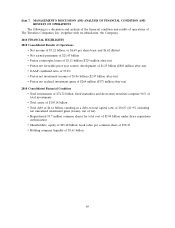Travelers 2010 Annual Report Download - page 71
Download and view the complete annual report
Please find page 71 of the 2010 Travelers annual report below. You can navigate through the pages in the report by either clicking on the pages listed below, or by using the keyword search tool below to find specific information within the annual report.adopt IFRS or how the adoption of IFRS (or the convergence of GAAP and IFRS, including the
project for valuing insurance contract liabilities) may impact our financial statements in the future.
Changes in accounting standards, particularly those that specifically apply to insurance company
operations, may impact the content and presentation of our reported financial results and could have
adverse consequences to our reported financial results, including lower reported results of operations
and shareholders’ equity and increased volatility and decreased comparability of our reported results
with other insurers.
The European Union’s executive body, the European Commission, is implementing new capital
adequacy and risk management regulations called Solvency II that would apply to our businesses across
the European Union beginning as soon as the fourth quarter of 2012. Under Solvency II, it is possible
that the U.S. parent of a European Union subsidiary could be subject to certain Solvency II
requirements if the regulator determines that the subsidiary’s capital position is dependent on the
parent company and the U.S. company is not already subject to regulations deemed ‘‘equivalent’’ to
Solvency II. In addition, regulators in countries where we have operations are working with the
International Association of Insurance Supervisors (and in the U.S., with the National Association of
Insurance Commissioners) to consider changes to insurance company supervision, including solvency
requirements and group supervision. While it is not yet known how these actions will impact us, such
regulation could result in a need for additional capital, increased costs of compliance, increased
disclosure and less flexibility in our capital management.
U.S. or non-U.S. insurance laws or regulations that are adopted or amended may be more
restrictive than current laws or regulations and may result in lower revenues and/or higher costs of
compliance and thus could materially and adversely affect our results of operations and limit our
growth.
A downgrade in our claims-paying and financial strength ratings could adversely impact our
business volumes, adversely impact our ability to access the capital markets and increase our
borrowing costs. Claims-paying and financial strength ratings are important to an insurer’s competitive
position. Rating agencies review insurers’ ratings periodically, and change their ratings criteria
periodically, and therefore our current ratings may not be maintained in the future. A downgrade in
one or more of our ratings could negatively impact our business volumes because demand for certain of
our products may be reduced, particularly because many customers may require that we maintain
minimum ratings to enter into or renew business with us. Additionally, we may find it more difficult to
access the capital markets and we may incur higher borrowing costs. If significant losses, including, but
not limited to, those resulting from one or more major catastrophes, or significant reserve additions or
significant investment losses were to cause our capital position to deteriorate significantly, or if one or
more rating agencies substantially increase their capital requirements, we may need to raise equity
capital in the future (which we may not be able to do at a reasonable cost or at all) in order to
maintain our ratings or limit the extent of a downgrade. A continued trend of more frequent and
severe weather-related catastrophes or a prolonged economic downturn may lead rating agencies to
substantially increase their capital requirements. For further discussion about our ratings, see,
‘‘Item 1—Business—Ratings.’’
The inability of our insurance subsidiaries to pay dividends to our holding company in sufficient
amounts would harm our ability to meet our obligations, pay future shareholder dividends or make
future share repurchases. Our holding company relies on dividends from our insurance subsidiaries to
meet our obligations for payment of interest and principal on outstanding debt, to pay dividends to
shareholders, to make contributions to our pension plan, to pay other corporate expenses and to make
share repurchases. The ability of our insurance subsidiaries to pay dividends to our holding company in
the future will depend on their statutory surplus, earnings and regulatory restrictions.
59


